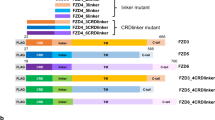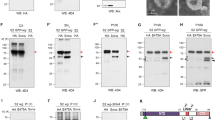Abstract
Signalling by Wnt proteins (Wingless in Drosophila) has diverse roles during embryonic development and in adults, and is implicated in human diseases, including cancer1,2. LDL-receptor-related proteins 5 and 6 (LRP5 and LRP6; Arrow in Drosophila) are key receptors required for transmission of Wnt/β-catenin signalling in metazoa3. Although the role of these receptors in Wnt signalling is well established, their coupling with the cytoplasmic signalling apparatus remains poorly defined. Using a protein modification screen for regulators of LRP6, we describe the identification of Xenopus Casein kinase 1 γ (CK1γ), a membrane-bound member of the CK1 family. Gain-of-function and loss-of-function experiments show that CK1γ is both necessary and sufficient to transduce LRP6 signalling in vertebrates and Drosophila cells. In Xenopus embryos, CK1γ is required during anterio-posterior patterning to promote posteriorizing Wnt/β-catenin signalling. CK1γ is associated with LRP6, which has multiple, modular CK1 phosphorylation sites. Wnt treatment induces the rapid CK1γ-mediated phosphorylation of these sites within LRP6, which, in turn, promotes the recruitment of the scaffold protein Axin. Our results reveal an evolutionarily conserved mechanism that couples Wnt receptor activation to the cytoplasmic signal transduction apparatus.
This is a preview of subscription content, access via your institution
Access options
Subscribe to this journal
Receive 51 print issues and online access
$199.00 per year
only $3.90 per issue
Buy this article
- Purchase on Springer Link
- Instant access to full article PDF
Prices may be subject to local taxes which are calculated during checkout




Similar content being viewed by others

References
Logan, C. Y. & Nusse, R. The Wnt Signaling Pathway in Development and Disease. Annu. Rev. Cell Dev. Biol. 20, 781–810 (2004)
Moon, R. T., Kohn, A. D., De Ferrari, G. V. & Kaykas, A. WNT and β-catenin signalling: diseases and therapies. Nature Rev. Genet. 5, 691–701 (2004)
He, X., Semenov, M., Tamai, K. & Zeng, X. LDL receptor-related proteins 5 and 6 in Wnt/β-catenin signalling: arrows point the way. Development 131, 1663–1677 (2004)
Belanger, C., Ansanay, H., Qanbar, R. & Bouvier, M. Primary sequence requirements for S-acylation of β2-adrenergic receptor peptides. FEBS Lett. 499, 59–64 (2001)
Knippschild, U. et al. The casein kinase 1 family: participation in multiple cellular processes in eukaryotes. Cell. Signal. 17, 675–689 (2005)
Peters, J. M., McKay, R. M., McKay, J. P. & Graff, J. M. Casein kinase I transduces Wnt signals. Nature 401, 345–350 (1999)
Mao, B. et al. LDL-receptor-related protein 6 is a receptor for Dickkopf proteins. Nature 411, 321–325 (2001)
Hummel, T., Attix, S., Gunning, D. & Zipursky, S. L. Temporal control of glial cell migration in the Drosophila eye requires gilgamesh, hedgehog, and eye specification genes. Neuron 33, 193–203 (2002)
Xu, Y., Piston, D. W. & Johnson, C. H. A bioluminescence resonance energy transfer (BRET) system: application to interacting circadian clock proteins. Proc. Natl Acad. Sci. USA 96, 151–156 (1999)
Tamai, K. et al. A mechanism for Wnt coreceptor activation. Mol. Cell 13, 149–156 (2004)
Mao, J. et al. Low-density lipoprotein receptor-related protein-5 binds to Axin and regulates the canonical Wnt signalling pathway. Mol. Cell 7, 801–809 (2001)
Tolwinski, N. S. & Wieschaus, E. Rethinking WNT signalling. Trends Genet. 20, 177–181 (2004)
Liu, G., Bafico, A., Harris, V. K. & Aaronson, S. A. A novel mechanism for Wnt activation of canonical signalling through the LRP6 receptor. Mol. Cell. Biol. 23, 5825–5835 (2003)
Cong, F., Schweizer, L. & Varmus, H. Wnt signals across the plasma membrane to activate the β-catenin pathway by forming oligomers containing its receptors, Frizzled and LRP. Development 131, 5103–5115 (2004)
Carninci, P. et al. Normalization and subtraction of cap-trapper-selected cDNAs to prepare full-length cDNA libraries for rapid discovery of new genes. Genome Res. 10, 1617–1630 (2000)
Shibamoto, S. et al. Cytoskeletal reorganization by soluble Wnt-3a protein signalling. Genes Cells 3, 659–670 (1998)
Wu, W., Glinka, A., Delius, H. & Niehrs, C. Mutual antagonism between dickkopf1 and dickkopf2 regulates Wnt/β-catenin signalling. Curr. Biol. 10, 1611–1614 (2000)
Boutros, M. et al. Genome-wide RNAi analysis of growth and viability in Drosophila cells. Science 303, 832–835 (2004)
Mao, B. et al. Kremen proteins are Dickkopf receptors that regulate Wnt/β-catenin signalling. Nature 417, 664–667 (2002)
Gawantka, V., Delius, H., Hirschfeld, K., Blumenstock, C. & Niehrs, C. Antagonizing the Spemann organizer: role of the homeobox gene Xvent-1. EMBO J. 14, 6268–6279 (1995)
Dosch, R., Gawantka, V., Delius, H., Blumenstock, C. & Niehrs, C. Bmp-4 acts as a morphogen in dorsoventral mesoderm patterning in Xenopus. Development 124, 2325–2334 (1997)
Reimer, T. et al. Phosphorylation of the N-terminal domain regulates subcellular localization and DNA binding properties of the peptidyl-prolyl cis/trans isomerase hPar14. J. Mol. Biol. 330, 955–966 (2003)
Zhai, L. et al. Casein kinase Iγ subfamily. Molecular cloning, expression, and characterization of three mammalian isoforms and complementation of defects in the Saccharomyces cerevisiae YCK genes. J. Biol. Chem. 270, 12717–12724 (1995)
Acknowledgements
We thank K. Bartscherer and M. Boutros for providing reagents and help with the Drosophila cell experiments, H. Clevers, R. Grosschedl, X. He, R. Moon, J. Nathans and R. Nusse for reagents, and H. Spring for confocal microscopy. We also thank S. Cohen and M. Boutros for comments on the manuscript. This work was supported by the Deutsche Forschungsgemeinschaft.
Author information
Authors and Affiliations
Corresponding authors
Ethics declarations
Competing interests
The sequence of Xenopus ck1γ2 has been deposited into GenBank (accession number DQ185136). Reprints and permissions information is available at npg.nature.com/reprintsandpermissions. The authors declare no competing financial interests.
Supplementary information
Supplementary Figure 1
Brief, schematic outline of the LRP6 modification screen that identified CK1γ as specific LRP6 kinase, characterisation of dominant negative CK1γ specificity and additional Xenopus GoF (axis duplication) as well as LoF (RT-PCR and luciferase reporter assays) experiments showing sufficiency and requirement of CK1γ in Wnt signalling. (PDF 210 kb)
Supplementary Figure 2
Vertebrate CK1 family, showing schematic comparison and amino acid sequence alignments of all members. (PDF 156 kb)
Supplementary Figure 3
Xenopus Laevis ck1γ1 and ck1γ2 mRNA expression patterns. (PDF 114 kb)
Supplementary Figure 4
Xenopus embryo LoF and GoF phenotypes showing role of CK1γ in Wnt mediated anterior-posterior patterning. (PDF 232 kb)
Supplementary Figure 5
Ser/Thr deletion analysis within ICD of FLAG-LRP6-DE(1-4)-δ87, revealing two CK1 site clusters required for Wnt signalling activity. (PDF 25 kb)
Supplementary Figure 6
Multiple sequence alignments showing evolutionary conserved nature of CK1 phosphorylation sites within LRP6 ICD and their juxtaposition with PPPS/TP priming sites. (PDF 32 kb)
Supplementary Figure 7
Characterisation of phosphor-specific T1479 and S1490 as well as phospo-independent T1479 polyclonal LRP6 peptide antibodies. (PDF 31 kb)
Supplementary Figure 8
Model for LRP6 phosphorylation by CK1γ and Axin recruitment. (PDF 118 kb)
Supplementary Table 1
List of statistics for morphological phenotypes obtained in Xenopus embryos corresponding to CK1γ GoF and LoF experiments shown in figures. (PDF 36 kb)
Supplementary Notes
This file contains the Supplementary Figure Legends and Supplementary Methods. (PDF 39 kb)
Rights and permissions
About this article
Cite this article
Davidson, G., Wu, W., Shen, J. et al. Casein kinase 1 γ couples Wnt receptor activation to cytoplasmic signal transduction. Nature 438, 867–872 (2005). https://doi.org/10.1038/nature04170
Received:
Accepted:
Issue Date:
DOI: https://doi.org/10.1038/nature04170
This article is cited by
-
The multi-CDK inhibitor dinaciclib reverses bromo- and extra-terminal domain (BET) inhibitor resistance in acute myeloid leukemia via inhibition of Wnt/β-catenin signaling
Experimental Hematology & Oncology (2024)
-
Mucociliary Wnt signaling promotes cilia biogenesis and beating
Nature Communications (2023)
-
The Wnt/β-catenin signalling pathway in Haematological Neoplasms
Biomarker Research (2022)
-
Wnt/β-catenin signaling in cancers and targeted therapies
Signal Transduction and Targeted Therapy (2021)
-
Small molecule induces mitochondrial fusion for neuroprotection via targeting CK2 without affecting its conventional kinase activity
Signal Transduction and Targeted Therapy (2021)
Comments
By submitting a comment you agree to abide by our Terms and Community Guidelines. If you find something abusive or that does not comply with our terms or guidelines please flag it as inappropriate.


